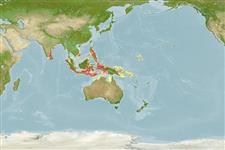>
Anguilliformes (Eels and morays) >
Ophichthidae (Snake eels) > Ophichthinae
Etymology: Hemerorhinus: Greek, hemeris, -idos = oak + Greek, rhinos = nose.
Eponymy: Lieutenant Cornelis E Hoorens van Heyningen was an officer aboard the ‘Siboga’ during the expedition led by Weber (1899–1900) that collected the holotype. (Ref. 128868), visit book page.
More on author: Weber.
Environment: milieu / Zona climática / intervalo de profundidade / distribution range
Ecologia
marinhas demersal; intervalo de profundidade 69 - 91 m (Ref. 40911). Tropical
Indo-West Pacific: Indonesia.
Tamanho / Peso / Idade
Maturidade: Lm ? range ? - ? cm
Max length : 11.5 cm TL macho/indeterminado; (Ref. 90102)
Descrição suscinta
Chaves de identificação | Morfologia | Morfometria
Body shape (shape guide): eel-like; Cross section: circular.
Found in sand bottoms (Ref 90102).
Ciclo de vida ou comportamento de acasalamento
Maturidade | Reprodução | Desova | Ovos | Fecundidade | Larvas
Smith, D.G. and J.E. McCosker, 1997. Ophichthidae. Snake eels, worm eels. p. 1662-1669. In K.E. Carpenter and V.H. Niem (eds.) FAO species identification guide for fishery purposes. The living marine resources of the WCP. Vol. 3. Batoid fishes, chimaeras and bony fishes part 1 (Elopidae to Linophrynidae). FAO, Rome. (Ref. 39782)
Status na Lista Vermelha da UICN (Ref. 130435: Version 2025-1)
Ameaça para os humanos
Harmless
Uso pelos humanos
Ferramentas
Relatórios especiais
Baixar XML
Fontes da internet
Estimates based on models
Preferred temperature (Ref.
123201): 24 - 26, mean 25.2 °C (based on 5 cells).
Índice de diversidade filogenética (Ref.
82804): PD
50 = 0.7500 [Uniqueness, from 0.5 = low to 2.0 = high].
Bayesian length-weight: a=0.00091 (0.00039 - 0.00215), b=2.99 (2.79 - 3.19), in cm total length, based on LWR estimates for this (Sub)family-body shape (Ref.
93245).
Nível Trófico (Ref.
69278): 3.4 ±0.5 se; based on size and trophs of closest relatives
Resiliência (Ref.
120179): Elevada, tempo mínimo de duplicação da população menor que 15 meses (Preliminary K or Fecundity.).
Fishing Vulnerability (Ref.
59153): Low vulnerability (10 of 100).
🛈
